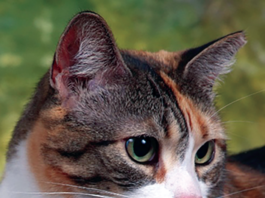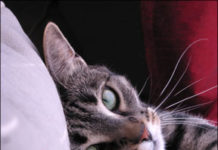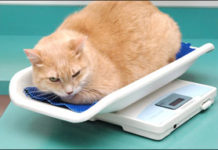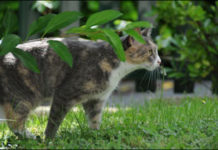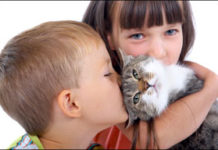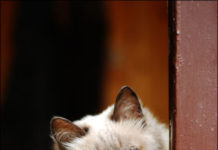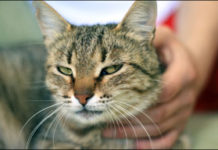How to Curb Destructive Scratching
Not long after youve invested in new furniture, your cat picks her favorite spot. And its not where she wants to take a nap, either. Its the place shes chosen to give herself a pedicure, and soon that beautiful new sofa looks like its gone through a shredder. Why Cats Claw. You may notice your cat flexing her nails when she first gets up and stretches or suddenly stop to sink her nails into the wall-to-wall carpeting as she crosses a room. She may scratch at the end of a burst of energy after playing with her favorite toy. Fabrics, carpet, wood, cardboard anything in your house made of materials your cat can sink her nails into can become a target for her clawing. "Clawing helps them shed the outer layer of their nails," says Katherine Houpt, VMD, PhD, and the James Law professor of Behavior Medicine at Cornell Universitys College of Veterinary Medicine. In addition to having a practical purpose, clawing serves a more esoteric function. Cats indoors and out leave olfactory and visual signals on the surfaces of whatever material they claw. "Indoors, cats leave the marks on well-traveled areas like doorways or in more obvious locations like the ends of a sofa," says Dr. Houpt.
Why Is Your Cat Coughing?
A wide variety of irritants from minor and transient to severe and indicative of a major health problem can affect any portion of the feline respiratory system, whose purpose is to warm and humidify inhaled air, deliver oxygen to the lungs, and expel carbon dioxide and other waste gases. A complex pathway of tracts and organs, the upper respiratory system consists of the nose; two nasal passages; the nasal cavity (a hollow structure surrounded by air-filled spaces that are situated just above and below the eyes); and the pharynx (a cavity behind the mouth) that opens, via a passageway called the larynx; to a tubular structure, the trachea, a flexible tube commonly referred to as the windpipe.
A Ban on Declawing?
The San Francisco Commission of Animal Control and Welfare wants the city to ban the declawing of cats. In a July hearing, the Commission voted 5 to 1 to recommend that the citys Board of Supervisors adopt an ordinance to ban the practice. (It would exclude cases where declawing is necessary for a cats health.) If passed, San Francisco will be the second city in the U.S. with such an ordinance. West Hollywood, CA, banned the practice in 2003.
Feline Blood Donors: Life-Saving
Blood can be the gift of life not just for us, but also for our cats. "A cat suffering severe injury or trauma may require blood transfusions," says Marjory Brooks, DVM, associate director of the coagulation section at Cornell Universitys Animal Health Diagnostic Laboratory. Other indications for transfusion include surgical complications and anemia caused by autoimmune disease, renal failure, chemotherapy, parasites in the intestinal tract or fleas. "Young kittens are especially at risk for blood-loss anemia caused by flea infestation," explains Dr. Brooks. Cats that need plasma proteins to combat liver disease, clotting problems or rat poisoning may also require a transfusion. Qualified Donors. Just like human donors, feline donors are required to take a battery of tests prior to giving blood - and not every cat qualifies. One qualification is weight: A donor cat usually weighs from 10 to 12 pounds. "The bigger the cat, the less risk of hypotension (low blood pressure) after donation," says Dr. Brooks.
Take Your Cat for a Walk!
Lucky, a striking gray tabby with bright green eyes, touches blades of grass, rolls around on the sunny deck and strolls over to sniff blackberry branches. Its all part of his regular walk around the fenced backyard with his human companion, who supervises his short outings. Since he is not particularly agile, his owner doesnt worry about quick escapes or even a leash. Buckys feline buddy, however, is a different matter. Jade, an agile black cat, loves the great outdoors as much as Bucky, but her athletic prowess easily has her up, up and away in a matter of seconds. Walking Jade outside requires an appropriate harness and leash. Whether you live with a Jade or a Bucky type, walking your cat will bear little resemblance to a conventional walk with the dog. Your cat probably will not like striding along at a brisk pace on a concrete sidewalk. That doesnt mean, however, that taking a walk with your cat isnt a great idea.
The Long Arm of the Law
We live in a litigious society. We have laws governing birth, death and the taxes in between, so its no surprise that we also have a host of laws relating to the animals weve taken into our homes. At the federal level, laws generally address issues such as the safety of pet food, the impact of hazardous products on pets, evacuating and transporting pets during emergencies and regulating the use of animals in research. But most of the laws directly affecting our pets are made at the state and local level. These ordinances can differ by city, township and county, and pet owners should contact local officials when getting a new pet or moving to a new place to find out what possible laws pertain.
Euthanasia: What to Expect and What Questions to Ask First
How can you possibly go on living without your cat - the beloved best friend with whom youve shared your life for the past 10 or 15 years? That is one of the challenging and possibly unanswerable questions that loving and conscientious cat owners must ponder when their veterinarian suggests that they might want to consider euthanasia. The Good Death. The term euthanasia is derived from two Greek words - eu, which means good, and thanatos, which means death. In a report published in 2001, the American Veterinary Medical Association (AVMA) defined this "good death" as follows: "Euthanasia is the act of inducing humane death in an animal. It is our responsibility as veterinarians and human beings to ensure that if an animals life is to be taken, it is done with the highest degree of respect, and with an emphasis on making the death as painless and distress-free as possible."
Recognize Senility in Your Aging Cat
Thanks to advances in veterinary medicine, its not uncommon for a cat to live to the ripe old age of 20 - roughly the physiologic equivalent of age 93 in a human. Thats the good news. The bad news is that cats, like humans, become increasingly susceptible to age-related disease conditions as they grow old, and most of these disorders are bound to have an effect on an animals behavior. For example, arthritis is likely to cause an active cat to slow down dramatically as it transitions through its golden years; kidney and urinary tract disease may affect its litter box behavior; progressive periodontal disease and tooth loss may alter its eating habits; and progressive hearing problems may make a cat decreasingly responsive to its environment. In some cases, however, an elderly cats behavioral peculiarities will remain unattributable to any underlying disease condition. In such a case, the animal is apt to be diagnosed as "senile," a vague term used to describe an animal that exhibits physiologically inexplicable cognitive dysfunction, the outward signs of which resemble those associated with age-related dementia and Alzheimers disease in humans.
Do Cats Exhibit Vengeful Behavior?
Vacations are wonderful, but theres nothing like home sweet home. You drive home from the airport, excited at the thought of sleeping in your own bed, and seeing your beloved cat. And she does seem happy to see you, greeting you with enthusiasm and sharing a few cuddles. Then you go off to unpack, and there she goes - right into your suitcase, urinating on top of your folded clothes. To you, it may feel like your cat is angry because you left her - and this is the way shes making her feelings known. But can a cat really hold a grudge? Experts look at it in another way. Cats and Vengeance. Ask many cat companions, and they will say "yes." They swear that cats can and will be vengeful at times. Besides suitcase antics, people point out the times their cats bite them minutes, or even hours, after they did something their cat disliked - such as grooming it. But animal behaviorists disagree.
Charges in Melamine Pet Food Recall
ChemNutra Inc., a Las Vegas-based ingredients broker, pleaded guilty on June 16 to federal charges of distributing tainted wheat gluten that led to the mass pet food recalls of 2007. The charges stem from a February 2008 indictment that alleged ChemNutra imported more than 800 metric tons of melamine-contaminated wheat gluten from China between November 2006, and February 2007, then sold the product to various pet food manufacturers.
A Health Checklist to Perform at Home
The owner is the veterinarians eyes and hands away from the office," explains Fred Scott, DVM, PhD, interim director of Cornells Feline Health Center. For this reason, it is important to be familiar with the steps involved in doing an at-home mini-physical examination on your cat. This should supplement your cats twice yearly trips to the veterinarian. Performing an at-home physical examination is much easier than you might think; in fact, Dr. Scott points out, the examination should be a normal extension of the regular attention you give your cat.
Stressful Times Impact Our Pets, Too
To you ever wonder if any of the anxiety and tension you sometimes bring home can also affect your pets? These challenging economic times can indirectly be hard on our cats, too. Experts feel that cats will indeed react to changes in the emotional behavior of their owners. So, if we believe that cats can sense our stress - and we certainly are living in an era of increased worry and anxiety - it stands to reason that our cats are experiencing higher levels of stress, as well. At what point are our feline friends exposed to more stress then they can handle?



